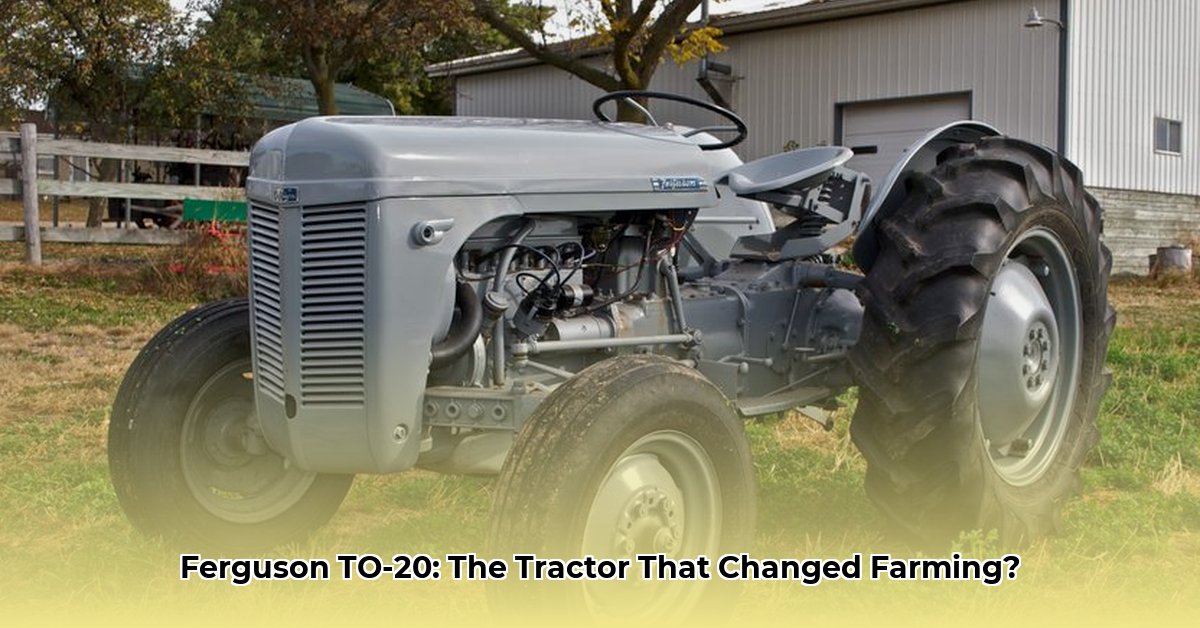
The Ferguson TO-20 tractor, a ubiquitous sight on farms in the post-World War II era, wasn't merely a machine; it represented a pivotal moment in agricultural history, subtly shaping the trajectory of sustainable farming practices. Produced from 1948 to 1951, approximately 60,000 of these compact tractors tilled fields worldwide, leaving an indelible mark on how we approach food production. But how did this seemingly humble machine contribute to a more sustainable future? The answer is multifaceted, and surprisingly nuanced. For more information on similar vintage tractors, see this great resource: vintage tractor info.
A Closer Look: The TO-20's Design and Specifications
Imagine a tractor designed for simplicity and practicality – that's the Ferguson TO-20. Its straightforward design prioritized ease of use and maintenance over sheer power. Unlike its larger, more powerful contemporaries, the TO-20 boasted a relatively compact 10-gallon fuel tank. While seemingly small, this feature contributed to surprisingly good fuel efficiency for its time. Its 20.7 horsepower (drawbar) and 25.4 horsepower (belt) output, while modest by today's standards, was sufficient for many smaller farms. This simplicity, coupled with straightforward controls and a robust mechanical design, significantly reduced downtime and the need for frequent repairs.
| Specification | Value | Notes |
|---|---|---|
| Engine | 4-cylinder gasoline | Reflecting the technology and environmental understanding of the era. |
| Fuel Tank Capacity | 10 US gallons (37.9 L) | Contributed to relatively high fuel efficiency for its time. |
| Drawbar Power | 20.7 hp (15.4 kW) | Adequate for many smaller farms and tasks. |
| Belt Power | 25.4 hp (18.9 kW) | Powered additional implements. |
| Production Years | 1948-1951 | A relatively short, but impactful production run. |
| Approximate Units Made | 60,000 | A substantial number for the era. |
Sustainable Agriculture: A Nuanced Relationship
The TO-20's contribution to sustainable agriculture is complex. While it wasn't explicitly designed with modern sustainability principles in mind, several aspects of its design inadvertently contributed to more environmentally friendly farming practices. Its fuel efficiency, compared to its contemporaries, reduced fuel consumption and associated emissions. The ease of maintenance minimized the need for frequent repairs and replacement parts, lowering the overall environmental impact of its operation. However, it's crucial to acknowledge its limitations. The reliance on gasoline as fuel, and its relatively low power output, fall short of today's sustainability standards. A full life-cycle assessment, considering manufacturing, use, and disposal, is necessary for a complete evaluation of its environmental impact. Could increased fuel efficiency and reduced maintenance have potentially counterbalanced the use of fossil fuels, thus making a contribution towards more sustainable agriculture for its time and given its context? More research is needed to answer this question definitively.
Historical Impact: A Revolution in Accessibility
The post-war agricultural boom spurred a demand for efficient and affordable machinery. The TO-20, with its accessible price point and ease of use, played a crucial role in this mechanization. Its affordability made it accessible to a broader range of farmers, empowering them to increase productivity and improve their livelihoods. This increased productivity, while potentially reducing labor demands, also minimized the environmental impact per unit of food produced. However, its impact must be understood within the context of its time. What was considered efficient then may not meet modern standards.
A Modern Perspective: Beyond Nostalgia
The Ferguson TO-20, while a remarkable achievement for its time, is far from a perfect example of sustainable agriculture by today's standards. Its use of gasoline and limited power are significant drawbacks when viewed through a modern lens. A comprehensive life-cycle assessment is crucial for a truly accurate understanding of its environmental impact. Nevertheless, the TO-20 serves as a valuable case study—a reminder of how technology's impact on sustainability is a dynamic and evolving concept. Its legacy lies not just in its design but in how it spurred the ongoing quest for more sustainable and efficient agricultural practices.
Conclusion: Lessons from the Past, Seeds for the Future
The Ferguson TO-20 tractor represents a fascinating intersection of technological advancement and evolving environmental consciousness. While its direct contributions to sustainable agriculture are nuanced, its accessibility and relatively high fuel efficiency for its time played a role in shaping a more productive, and potentially less environmentally intensive, agricultural landscape. Its story underscores the iterative nature of progress toward sustainable agriculture – a journey guided by lessons learned from the past and a commitment to continuous innovation. The TO-20's legacy continues to inspire the search for more eco-friendly farming solutions.